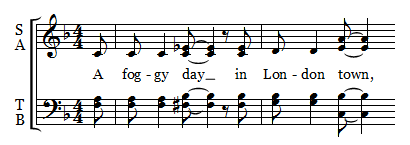 Rehearsing notes with a choir is not very enthralling. The director is singing the notes (or playing them on the piano) and the singers are repeating the notes. It may take a lot of time before all voice groups know their parts. Probably the director starts with the top part (because it often is the melody) and works his way down. By the time the basses have their turn, five or ten minutes may have passed.
Rehearsing notes with a choir is not very enthralling. The director is singing the notes (or playing them on the piano) and the singers are repeating the notes. It may take a lot of time before all voice groups know their parts. Probably the director starts with the top part (because it often is the melody) and works his way down. By the time the basses have their turn, five or ten minutes may have passed.
To prevent the singers to get bored, a director should try to make rehearsing notes as interesting as possible. Below are some suggestions.
Let the other voice groups sing along
Whenever you are rehearsing notes with a specific voice group, let the other choir members sing along. For example, if you are studying the alto notes, let the sopranos, tenors and basses join in. At first, the other voice groups might object, because they see no need for them to know the alto notes. They are right. But there is so much more to learn than the notes! In this way, all singers are practicing their sight reading. The singers will learn the lyrics (so later on in learning their own part, the lyrics will be familiar). The singers will learn how to blend well. And the choir members will get to know the other parts, which is useful for understanding the chord progressions.
Sometimes singing along with other parts is not easy, because of the height of the notes. For example, a soprano part may be too high for the altos and a bass part too low for the tenors. To resolve this, just allow the singers to sing notes in a different octave.
A slight disadvantage of singing along with other parts, is that singers may get confused and forget their own part. In practice, this won’t be very much of a problem. If this occurs, just let the singers briefly repeat their own part.
Rehearse short bits
Another technique to prevent boredom in rehearsing the notes, is to focus on short pieces of music. Just one line of four or eight bars will do. Because the singers learn just a few notes, they tend to make few mistakes. But the major advantage is the rehearsal is quickly switching between the voice groups. In this way, all singers will stay awake and focused.
Make voice pairs
You don’t have to rehearse all parts separately before starting to make combinations. Try to make voice pairs as soon as two voices know their parts. Try to combine voices that are singing a lot of thirds or sixths, because they sound good together.
Suppose you are studying the following notes:

The female voices form a good combination, as do the men. Thus, study the soprano and the alto, and then sing them together. Next, study the men’s voices and sing them together. Before singing all parts together you can make other voice pairs. Combining sopranos and tenors is unwise, because of the dissonant between A and B-flat. However, the combinations soprano+bass and alto+tenor are well possible. Next, sing with all four voices.
Let all voice groups sing their notes and help a specific voice group
Suppose one of the voice groups (the tenor for example) has difficulties singing the notes, but the other groups know their parts. In such a situation you could rehearse the tenor notes separately and let the other voices wait. Instead, you could just let all voices sing softly, at the same time that you sing along with the tenors. As an alternative, let the singers sing on ‘mm’ instead of lyrics. In this way, all singers stay active, while you are helping the tenors.